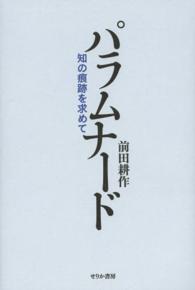Full Description
This is the first of two volumes of research on discourse particles focusing exclusively on the languages of Asia from the perspective of formal as well as non-formal semantics and pragmatics.
Within linguistics, there has been a great deal of interest in discourse particles, especially within semantics and pragmatics. The term 'discourse particles' has been used to cover a broad range of phenomena, including such things as 'sentence-final particles,' 'discourse adverbs,' and other related phenomena. However, most research in the area (particularly within formal semantics and pragmatics) focuses on a restricted set of languages, and there is little consensus on the proper formal treatment of particles, partly due to the limited range of data available.
In recent years, there has been extensive development of the formal approach to discourse particles, which often treats these words as devices for marking information updates. It is also vital to extend this data to non-Western languages like Japanese, Korean, or Chinese. This edited volume includes chapters on Japanese, Mandarin, Tagalog, Kimaragang Dusun, Malay, Singlish, Thai, and Vietnamese. The chapters are informed by recent theoretical work in formal semantics and pragmatics relating to the meaning of particles. The collection contributes to our theoretical understanding of the meaning of discourse particles and to empirical knowledge of discourse particles in the languages of Asia. It will be of interest to postgraduate students and scholars of semantics and pragmatics.
Contents
Introduction; 1. On the mirative use of the no (da) construction in Japanese; 2. Evidentiality, inference, conclusion: Japanese no as a particle and complementizer; 3. Mandarin Chinese sentence-final de as a marker of private evidence; 4. How are contrasts marked? - the case of ne in in Mandarin Chinese; 5. Cantonese question particles; 6. Softness, assertiveness and their expression via Cantonese sentence-final particles; 7. Formality weakening and the underspecified expressive yo in Korean







